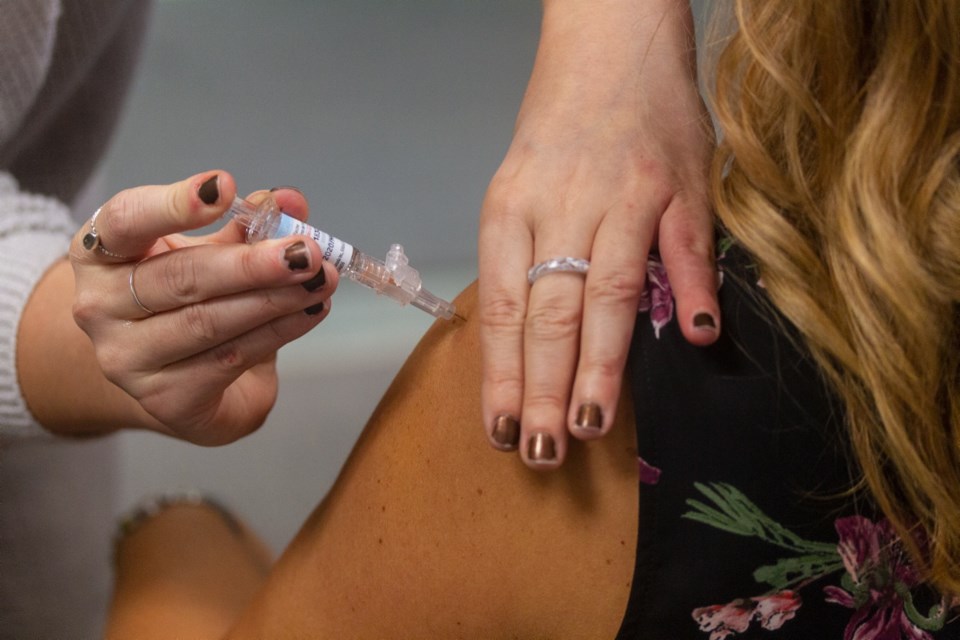What happens when our winter flu season meets the COVID-19 pandemic?
Health officials in Canada are hoping they don’t have to find out.
Provincial and territorial governments, including B.C., have increased their orders for the influenza vaccine this year in preparation for a second surge of COVID-19 and a simultaneous outbreak of seasonal flu.
Health Canada reports that orders have been placed with suppliers for more than 13 million doses of the influenza vaccine this year. Last year, Canada ordered 11.2 million doses.
To reduce the load on the health-care system from simultaneous outbreaks of flu and COVID-19, the Public Health Agency of Canada also plans to promote the flu vaccine in populations at higher risk of complications from influenza.
The flu is among the 10 leading causes of death in Canada, linked to an average of 3,500 deaths every year.
Dr. Dee Hoyano, medical health officer at Island Health, said B.C. expects higher demand for the flu vaccine compared with previous years. Last year, B.C. purchased 1.5 million doses. “We want people to get vaccinated against influenza every year because of the impacts of influenza, and this year is no different. But with COVID on top of that, we certainly want to avoid the situation where people are having to deal with both of those at the same time.”
Influenza viruses circulate year round and can be introduced by people who have been travelling. Health officials believe infection rates peak in the winter months because children return to school, people have closer indoor interactions and the virus is more stable due to lower temperatures and reduced UV light.
The good news is that efforts to control the COVID-19 virus work hand-in-hand with influenza prevention, said Hoyano. Handwashing, social distancing, wearing masks and staying home when sick are important measures to prevent COVID-19 and also prevent influenza.
“I’m hoping everyone will continue these measures into our traditional flu season,” said Hoyano. “We know when people started paying attention and public-health measures went into place in the spring, that essentially ended our flu season mid-week. We had almost no influenza circulating.”
The decrease in influenza cases might have been in part due to the fact people stopped going to their doctors or avoided the hospital, said Hoyano. But everyone who came into the hospital with respiratory symptoms was tested and flu reports dropped off dramatically.
“Influenza rates were going up and up and up, and at the end of March, it took a nosedive,” she said.
In the southern hemisphere, which is experiencing its winter, there are very low levels of influenza right now, said Hoyano.
“Part of that is all the measures that people are taking for COVID prevention. There’s some concern that people aren’t testing as much for influenza, but I think it’s more that people are doing their handwashing and staying home when sick.
“If we can replicate that here, we should have relatively light influenza activity this fall.”
In 2009, during the H1N1 or swine flu pandemic, there was a big emphasis on hand hygiene that helped control norovirus activity that year, said Hoyano. “At some point, we’ll switch over to looking more closely for influenza to measure how much activity there is versus COVID. But hopefully, overall, we won’t see as high numbers of influenza if we are doing COVID prevention.”
The Public Health Agency of Canada recommends that everyone six months and older get the flu shot, especially people at high risk of complications and those who can pass on the flu virus to those at high risk.
Provinces decide how much vaccine to order, based on past experience and the influenza forecast, and when to start vaccination programs.
Hoyano said when the province starts flu vaccination depends on when the vaccine is shipped, which, in turn, depends on how early the manufacturers can get the vaccine out. That can vary from year to year. “As soon as it is available, we want to start vaccinating, so people can get protected quickly,” said Hoyano.
The medical health officer said she hopes there will be enough vaccine for everyone who wants it. A distribution problem last year resulted in reported shortages.
Health Canada said there is not enough information on circulating strains to predict which will be dominant in Canada this flu season.



